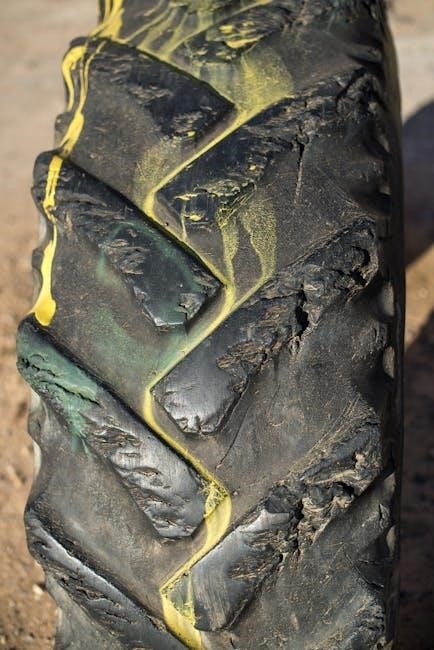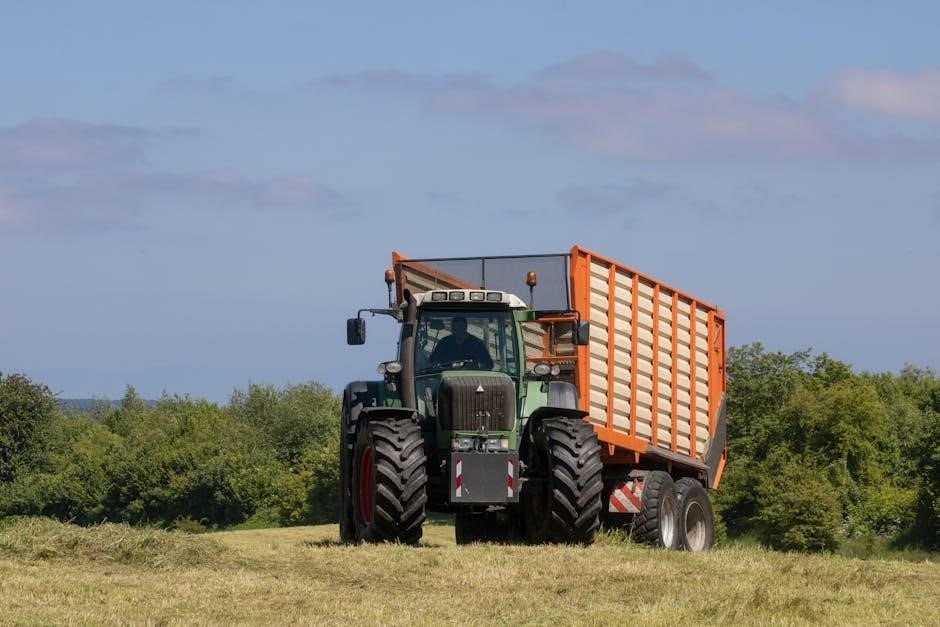Tractor tires are crucial for optimal performance, stability, and traction. Choosing the right size is essential for efficiency, safety, and long-term operation.
Understanding Tractor Tire Sizes
Understanding tractor tire sizes is essential for ensuring optimal performance and safety. Tire sizes are typically indicated using a combination of numbers and letters, often found on the tire’s sidewall; Deciphering these markings can seem daunting, but it is crucial for selecting the right tires for your tractor. Proper tire size directly impacts traction, load capacity, and overall efficiency.
Incorrectly sized tires can lead to reduced performance, increased wear and tear, and potential safety hazards. Therefore, familiarizing yourself with the standard and metric formats used to denote tire sizes is a worthwhile investment. This knowledge empowers you to make informed decisions, ensuring your tractor operates smoothly and effectively across various terrains and tasks. Understanding these sizes also helps in converting between different tire types, such as bias-ply and radial tires, further optimizing your tractor’s capabilities.

Decoding Tire Markings
Tire markings can be confusing, but understanding them is crucial for selecting the correct tires. These markings provide essential information about the tire’s size, construction, and intended use.
Standard Tire Size Format

The standard tire size format is commonly used and displayed on the tire sidewall. A typical example is 14.9-24, where 14.9 represents the tire’s width in inches, indicating the section width of the tire. The number 24 represents the rim diameter in inches, essential for matching the tire to the tractor’s wheel.
Understanding this format ensures proper fitment and optimal performance. It helps in selecting the right tire for specific tasks, enhancing the tractor’s capabilities. Proper tire size protects equipment from unnecessary stress and damage. Always consult your tractor’s manual for specific recommendations on tire size.
Metric Tire Size Format
The metric tire size format is an alternative way to represent tire dimensions, often seen as, for example, 420/85R34. Here, 420 represents the tire width in millimeters. The number 85 is the aspect ratio, indicating the sidewall height as a percentage of the tire width. “R” signifies radial construction, and 34 denotes the rim diameter in inches.
Converting between standard and metric formats is crucial for ensuring compatibility. Knowing these measurements aids in selecting the correct tire for your tractor. This knowledge supports informed decisions that boost tractor performance, protecting it from potential harm. Always verify the load-carrying capacity.

Tire Types and Their Applications

Tractor tires come in different types, like radial and bias-ply, each suited for specific applications. Understanding their differences is vital for selecting the right tire.
Radial Tires
Radial tires are constructed with plies that run perpendicular to the tire’s circumference. This design allows the sidewall and tread to function more independently, offering several advantages. Radial tires typically provide a larger footprint, which leads to better traction and reduced soil compaction. Their flexible sidewalls enhance ride comfort, especially on uneven terrain, making them ideal for field work and tasks requiring prolonged operation.
The construction of radial tires also contributes to better fuel efficiency due to reduced rolling resistance. These tires are well-suited for tractors used in heavy-duty applications, such as plowing, planting, and harvesting, where maximizing performance and minimizing soil impact are essential. Furthermore, radial tires often have a longer lifespan compared to bias-ply tires, making them a cost-effective choice over time.
Bias-Ply Tires
Bias-ply tires, also known as cross-ply tires, feature a construction where the plies run diagonally, overlapping each other from bead to bead. This design creates a rigid tire structure that is highly resistant to punctures and cuts, making them suitable for rugged terrains and demanding tasks. Bias-ply tires are generally more affordable than radial tires, making them a budget-friendly option for many tractor owners.
Their stiff sidewalls provide excellent stability, particularly in applications that require heavy lifting or side-hill operations. While bias-ply tires offer durability and cost-effectiveness, they tend to have a smaller footprint and higher rolling resistance compared to radial tires. This can result in reduced traction, increased soil compaction, and lower fuel efficiency. Bias-ply tires are commonly used in applications where puncture resistance and stability are prioritized over ride comfort and fuel economy.

Choosing the Right Tire Size
Selecting the correct tire size is essential for maximizing performance, efficiency, and safety. Consider the tractor manual, rim diameter, and load capacity for optimal results.
Consulting the Tractor Manual
The tractor’s manual is your primary resource for identifying the correct tire size. This essential guide provides specific recommendations from the manufacturer regarding tire size, type, and compatibility. Always consult the manual before making any decisions about replacing or upgrading your tires. The manual contains crucial information that ensures optimal performance and safety.
Following the manufacturer’s recommendations helps prevent potential damage to your tractor and ensures that it operates efficiently. The manual often includes details on load capacity, tire pressure, and other important specifications. Ignoring these guidelines can lead to reduced performance, increased wear and tear, or even safety hazards. Therefore, always prioritize the information in your tractor manual.
Matching Rim Diameter
Ensuring that the tire’s rim diameter matches your tractor’s wheel size is crucial for proper fit and safe operation. The rim diameter refers to the size of the wheel on which the tire is mounted. For instance, a tire size of 14.9-24 indicates that it requires a 24-inch rim. Using a tire with an incorrect rim diameter can lead to installation difficulties, tire slippage, or even tire failure.

Always verify that the rim diameter specified on the tire matches the diameter of your tractor’s wheels before attempting to mount the tire. This ensures a secure and proper fit, which is essential for maintaining stability and preventing accidents. A mismatched rim diameter can compromise the tire’s ability to hold air properly and can affect the overall performance of your tractor.
Considering Load Capacity
When selecting tractor tires, it’s imperative to check the tire’s load-carrying capacity to ensure it meets the weight requirements of your tractor and any implements you intend to use. The load capacity indicates the maximum weight a tire can safely support at a specified inflation pressure. Overloading tires can lead to premature wear, tire failure, and potentially dangerous operating conditions.
Refer to your tractor’s manual and the tire manufacturer’s specifications to determine the appropriate load capacity for your needs. Consider the weight of the tractor itself, as well as the weight of any attachments such as plows, mowers, or loaders. Ensure that the tires you choose have a load capacity that exceeds the total weight to provide a safety margin and ensure optimal performance and longevity.

Tractor Tire Conversion Chart
A tractor tire conversion chart simplifies replacing or upgrading tires. It aligns standard and metric sizes, improving tractor performance through informed choices;
Standard to Radial Conversion
Converting from standard bias-ply tires to radial tires on your tractor involves understanding the size differences. Radial tires often offer improved performance and ride comfort, but it’s crucial to find the correct radial equivalent for your existing standard tire size. Using a conversion chart designed for this purpose is highly recommended.
The chart will provide a direct radial tire size that matches the overall diameter and load capacity of your current standard tires. For example, a standard tire size like 11.2-24 might convert to a radial size such as 11.2R24. Always verify that the rim diameter is compatible. Consulting a tire specialist can also ensure proper fitment and performance.
Standard to Metric Conversion
Converting from standard (inch-based) to metric tire sizes is essential when radial tires are needed. Metric sizes are expressed in millimeters and a percentage aspect ratio. Use a conversion chart to find the correct metric equivalent for your standard tire size.
For example, a standard tire size like 14.9-24 might convert to a metric size such as 380/85R24. The first number (380) is the tire width in millimeters, and 85 is the aspect ratio (height as a percentage of width). The R indicates radial construction, and 24 represents the rim diameter in inches. Matching the overall diameter is crucial for maintaining proper tractor functionality.

Maintaining Tractor Tires
Proper maintenance extends the life of your tractor tires and keeps your machine running efficiently. Regular checks and correct inflation are crucial for optimal performance.
Proper Inflation
Maintaining proper tire inflation is critical for maximizing the lifespan and performance of tractor tires. Underinflated tires can lead to excessive wear on the sidewalls, increased fuel consumption, and reduced traction. Conversely, overinflated tires can cause a rough ride, uneven wear in the center of the tread, and a higher risk of punctures.
Regularly check the tire pressure using a reliable gauge and adjust it according to the manufacturer’s recommendations, which are typically found in the tractor’s manual or on a sticker on the tractor itself. Tire pressure should be checked when the tires are cold, as heat can increase pressure.
Adjust tire pressure based on the load being carried. Heavier loads require higher inflation pressures to maintain optimal performance and prevent damage. Always ensure that the tire pressure is within the recommended range for the specific tire size and type being used. Proper inflation ensures even weight distribution, improving traction, reducing soil compaction, and extending tire life.

Resources for Finding Tire Sizes
Finding the correct tractor tire sizes can be achieved through online retailers, specialized tire dealers, and tractor manufacturers’ websites. These resources offer comprehensive information and detailed product specifications.
Online Tire Retailers
Numerous online tire retailers offer extensive catalogs of tractor tires, providing detailed specifications, customer reviews, and competitive pricing. These platforms allow you to easily compare different brands, models, and sizes, ensuring you find the perfect fit for your tractor. Many retailers also offer convenient shipping options, bringing the tires directly to your doorstep.
When browsing online retailers, pay close attention to the tire specifications, including size, load capacity, and tread pattern. Read customer reviews to gain insights into the tire’s performance and durability. Additionally, check the retailer’s return policy and warranty information before making a purchase.